হিন্দু উৎসবের তালিকা
বিশ্ব জুড়ে হিন্দুরা বিভিন্ন সংখ্যক উৎসব উদযাপন করে এগুলি সাধারণত প্রাচীন ভারতীয় ঘটনাগুলিকে চিহ্নিত করে এবং প্রায়শই ঋতু পরিবর্তনের সাথে মিলে যায়।[1] এই উৎসব গুলো সাধারণত সৌর পঞ্জিকার একটি নির্দিষ্ট বার্ষিক তারিখ অথবা লুনিসোলার ক্যালেন্ডারের একটি নির্দিষ্ট দিনে অনুষ্ঠিত হয় । আঞ্চলিকভাবে উৎসব পালনের সাথে কিছু ভিন্নতা রয়েছে। এমন অসংখ্য উৎসব রয়েছে যা মূলত নির্দিষ্ট সম্প্রদায়ের দ্বারা বা ভারতীয় উপমহাদেশের নির্দিষ্ট অঞ্চলে পালিত হয় ।
| হিন্দুধর্ম |
|---|
| ধারাবাহিকের অংশ |
 |
|
পরিভাষা
উৎসব
উৎসব একটি সংস্কৃত শব্দ। সংস্কৃত শব্দ উত্সব এসেছে " উৎ " শব্দ থেকে যার অর্থ "অপসারণ" এবং " সব " যার অর্থ "জাগতিক দুঃখ"। আনন্দপূর্ণ বা জাঁকজমকপূর্ণ সামাজিক বা ধর্মীয় অনুষ্ঠান।
পালনের সময়কাল (তিথি)
হিন্দু ক্যালেন্ডারের তারিখগুলি সাধারণত একটি লুনিসোলার ক্যালেন্ডার অনুসারে নির্ধারিত হয় । বৈদিক টাইমকিপিংয়ে , একটি মাস হল একটি চান্দ্র মাস, একটি পক্ষ হল একটি চান্দ্র পাক্ষিক এবং একটি তিথি হল একটি চান্দ্র দিন ।
তদুপরি চন্দ্র মাসের দুটি সংজ্ঞা প্রচলিত আছে: আমন্ত এবং পূর্ণিমান্ত (চান্দ্র মাস যথাক্রমে অমাবস্যা এবং পূর্ণিমা দিয়ে শেষ হয়)। ফলস্বরূপ একই দিনটিকে ভিন্ন ভিন্ন কিন্তু সন্নিহিত মাস হিসেবে উল্লেখ করা যেতে পারে। যদি শুক্লপক্ষের সময় একটি উত্সব ঘটে তবে দুটি ঐতিহ্য একই মাসে এটি নির্ধারণ করে; যদি কৃষ্ণপক্ষের সময় একটি উত্সব ঘটে তবে দুটি ঐতিহ্য একে আলাদা কিন্তু সংলগ্ন মাসে নির্ধারণ করে।
| উৎসব | মাস | পক্ষ | তিথি | |
|---|---|---|---|---|
| আমন্তা | পূর্ণিমান্ত | |||
| গুড়ি পড়ওয়া | ||||
| রাম নবমী | ||||
| অক্ষয় তৃতীয়া | ||||
| গুরু পূর্ণিমা | ||||
| নাগ পঞ্চমী | ||||
| রাখীবন্ধন | ||||
| কৃষ্ণ জন্মাষ্টমী | ||||
| গণেশ চতুর্থী | ||||
| সর্বপিত্রু অমাবস্যা | ভাদ্রপদ | কৃষ্ণ | প্রথমা | |
| দুর্গা অষ্টমী
(নবরাত্রি, দুর্গাপূজার উপাদান) |
||||
| মহা নবমী
(নবরাত্রি, দুর্গাপূজার উপাদান) |
আশ্বিনা | শুক্ল | নবমী | |
| বিজয়া দশমী
(দুর্গা পূজার উপাদান) |
||||
| করভা চৌথ | ||||
| ধন তেরাস
(দীপাবলির উপাদান) |
||||
| নরক চতুর্দশী
(দীপাবলির উপাদান) |
||||
| লক্ষ্মী পূজা
(দীপাবলির উপাদান) |
||||
| বালি পদ্যামি
(দীপাবলির উপাদান) |
||||
| ভাই দুজ
(দীপাবলির উপাদান) |
||||
| বসন্ত পঞ্চমী | ||||
| মহা শিবরাত্রি | ||||
| হোলিকা দহন | ||||
সাবলিস্ট
- পাঞ্জাবের হিন্দু উৎসবের তালিকা
- জগন্নাথ মন্দির, পুরীতে পালন করা উৎসবের তালিকা
- সিন্ধি উৎসবের তালিকা
প্রধান হিন্দু উৎসবের তালিকা ও বর্ণনা
নিম্নলিখিত তালিকায় দেখানো তিথি গুলি আমন্ত ঐতিহ্য অনুসারে।
| প্রধান হিন্দু উৎসব | ছবি | পালনের হিন্দু তিথি | বর্ণনা |
|---|---|---|---|
| বোগি, লোহরি এবং লাল লই |
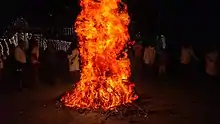 অন্ধ্রপ্রদেশে বোগির আগুন |
ভোগী ৪-দিনের সংক্রান্তি উৎসবের প্রথম দিনটিকে চিহ্নিত করে এবং মকর সংক্রান্তির একদিন আগে ঘটে যা সূর্যের মকর রাশিতে রূপান্তরকে চিহ্নিত করে । | এটি তামিলনাড়ু , কর্ণাটক , অন্ধ্রপ্রদেশ এবং তেলেঙ্গানায় ব্যাপকভাবে পালিত একটি উৎসব ।
ভোগীর উপর, লোকেরা পুরানো এবং পরিত্যক্ত জিনিসগুলিকে পরিত্যাগ করে এবং পরিবর্তন বা রূপান্তর ঘটায় এমন নতুন জিনিসগুলিতে মনোনিবেশ করে। ভোরবেলা, লোকেরা কাঠের লগ, অন্যান্য শক্ত জ্বালানী এবং কাঠের আসবাবপত্র দিয়ে আগুন জ্বালায় যা আর কাজে লাগে না।[2] পরিত্যক্ত জিনিসের নিষ্পত্তি হল যেখানে সমস্ত পুরানো অভ্যাস, বদনাম, সম্পর্কের প্রতি আসক্তি এবং বস্তুগত জিনিস রুদ্রের জ্ঞানের যজ্ঞের আগুনে উৎসর্গ করা হয় , যা "রুদ্র গীতা জ্ঞান যজ্ঞ" নামে পরিচিত। এটি উপলব্ধি, রূপান্তর এবং আত্মার শুদ্ধিকরণের প্রতিনিধিত্ব করে এবং বিভিন্ন ঐশ্বরিক গুণাবলীকে আত্মস্থ করে। |
| মকর সংক্রান্তি বা পৌষ সংক্রান্তি বা পোঙ্গল বা উত্তরায়ণ বা মাঘে সংক্রান্তি বামাঘী |
.JPG.webp) অন্ধ্রপ্রদেশে মকর সংক্রান্তিতে প্রবেশদ্বার ও রাস্তা সাজিয়ে রঙিন মেঝে শিল্পকর্ম ( মুগুলু )  কলম্বোতে থাই পোঙ্গল |
মকর সংক্রান্তি বা পোঙ্গল সূর্যের মকর রাশিতে রূপান্তরকে চিহ্নিত করে । এটি দিনের সময়কালের ধীরে ধীরে বৃদ্ধিকে চিহ্নিত করে। পোঙ্গল হল উত্তরায়ণের প্রথম দিন এবং তামিল থাই মাসের শুরুর সাথে মিলে যায় । |
পোঙ্গল তামিলনাড়ুর অন্যতম জনপ্রিয় ফসল কাটার উৎসব। পোঙ্গল প্রতি বছর জানুয়ারির মাঝামাঝি সময়ে ঘটে এবং উত্তরায়ণ (সূর্যের উত্তর দিকে যাত্রা) শুরু হয়। পোঙ্গল উৎসব চার দিন ধরে চলে। উদযাপনের মধ্যে রয়েছে কোলাম আঁকা, দোলনা এবং সুস্বাদু পোঙ্গল রান্না।[3] এই দিনটি মকর সংক্রান্তির সাথে মিলে যায় । পোঙ্গলকে বীরত্বের খেলা হিসাবে উত্সবের অংশ হিসাবে জাল্লিকাট্টু দ্বারাও স্মরণ করা হয় এই দিনে সূর্য মকর রাশিতে প্রবেশ করার কারণে গ্রেগরিয়ান ক্যালেন্ডারের ১৪ জানুয়ারী এই উত্সবটি পালিত হয়। |
| বসন্ত পঞ্চমী (সরস্বতী পূজা) |
 কলকাতার বসন্ত পঞ্চমীতে দেবী সরস্বতী হলুদ শাড়ি পরেছিলেন। সে এক কোণে বই নিয়ে বীণাকে ধরে এক দোলনায় বসে আছে |
মাঘ মাসের মোমের চাঁদের পঞ্চম দিন ( হিন্দু ক্যালেন্ডার ) | বসন্ত পঞ্চমী (যাকে বাঙালি এবং ওড়িয়াদের দ্বারা সরস্বতী পূজাও বলা হয় ) পালিত হয় জ্ঞান ও শিল্পের দেবী সরস্বতীর আশীর্বাদের জন্য ।[4] |
| থাইপুসাম বা কাভাদি আত্তম |
 থাইপুসামের সময় মুরুগান |
থাই মাসের তামিল মাসের পূর্ণিমা দিন | থাইপুসাম হল একটি হিন্দু উৎসব যা বেশিরভাগ তামিল সম্প্রদায়ের দ্বারা পালিত হয়। থাইপুসাম শব্দটি তামিল মাসের নাম থাই এবং পুসাম থেকে এসেছে, যা উৎসবের সময় চাঁদের অবস্থানের কাছাকাছি একটি তারাকে বোঝায়। উৎসবটি সেই উপলক্ষকে স্মরণ করে যখন পার্বতী মুরুগানকে একটি বর্শা দিয়েছিলেন যাতে তিনি দুষ্ট রাক্ষস সূরপদ্মনকে পরাজিত করতে পারেন ।
কাভাদি আট্টম ( তামিল :காவடி ஆட்டம்) হল একটি নৃত্য যা ভক্তদের দ্বারা সম্পাদিত যুদ্ধের তামিল দেবতা মুরুগানের আনুষ্ঠানিক পূজার সময়।[5] এটি প্রায়ই থাইপুসাম উৎসবের সময় সঞ্চালিত হয় এবং ঘৃণা বন্ধনের উপর জোর দেয়। কাভাদি নিজেই একটি শারীরিক বোঝা যার মাধ্যমে ভক্তরা ঈশ্বর মুরুগানের কাছে সাহায্য প্রার্থনা করে।[6] |
| মহা শিবরাত্রি |
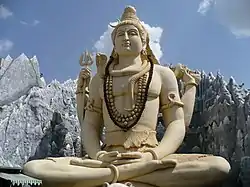 ধ্যানরত শিবের মূর্তি |
মাঘের অস্তমিত চাঁদের ত্রয়োদশ রাত ( আমন্ত ) / ফাল্গুন ( পূর্ণিমন্ত ) | মহা শিবরাত্রি হল শিবের মহান রাত্রি , যে সময়ে শিবের অনুসারীরা ধর্মীয় উপবাস পালন করে এবং শিবকে বায়েল (বিল্ব) নিবেদন করে । মহাশিবরাত্রি উত্সব বা 'শিবের রাত্রি' হিন্দু ত্রিত্বের অন্যতম দেবতা, ভগবান শিবের সম্মানে ভক্তি এবং ধর্মীয় উত্সাহের সাথে পালিত হয়। ফাল্গুনের অমাবস্যার 14তম রাতে শিবরাত্রি পড়ে(ফেব্রুয়ারী মার্চ). শিবরাত্রি উৎসব উদযাপন করে ভক্তরা দিনরাত উপবাস করে এবং শিব লিঙ্গের আচার উপাসনা করে ভগবান শিবকে তুষ্ট করতে। শিবরাত্রি উৎসবকে চিহ্নিত করার জন্য, ভক্তরা খুব ভোরে ঘুম থেকে উঠে এবং বিশেষ করে গঙ্গা নদীতে স্নান করে। নতুন নতুন জামাকাপড় পরে ভক্তরা নিকটবর্তী শিব মন্দিরে গিয়ে শিব লিঙ্গকে দুধ, মধু, জল ইত্যাদি দিয়ে স্নান করতে যান। শিবরাত্রিতে, দিনরাত ভগবান শিবের আরাধনা চলতে থাকে। প্রতি তিন ঘন্টা অন্তর পুরোহিতরা শিবলিঙ্গমকে দুধ, দই, মধু, ঘি, চিনি এবং জল দিয়ে স্নান করে "ওম নমঃ শিবায়" এবং মন্দিরের ঘণ্টা বাজানোর মধ্য দিয়ে পূজা করে। জাগরণ (রাত্রিব্যাপী জাগরণ) শিব মন্দিরগুলিতেও পালন করা হয় যেখানে প্রচুর সংখ্যক ভক্ত ভগবান শিবের প্রশংসায় স্তোত্র ও ভক্তিমূলক গান গেয়ে রাত কাটান।[7] |
| হোলি (দোলযাত্রা) |
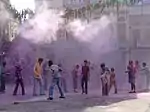 রাজস্থানের পুষ্করে হোলি  হোলি উদযাপনের পরে একটি ছোট বাচ্চা (হরিদ্বার)  রাজস্থানের উদয়পুরে জগদীশ মন্দিরের সামনে হোলিকা দহন (বনফায়ার) |
ফাল্গুন মাসের পূর্ণিমা (হিন্দু ক্যালেন্ডার) | হোলি বা ফাগওয়াহ একটি জনপ্রিয় বসন্ত উৎসব। হোলি ভগবান বিষ্ণুর ভক্ত প্রহ্লাদ কর্তৃক অসুর হোলিকার বধের স্মৃতিচারণ করে । সুতরাং, উৎসবের নামটি সংস্কৃত শব্দ "হোলিকা দহনম" থেকে এসেছে, যার আক্ষরিক অর্থ হল "হোলিকার বধ"। উৎসবটিকে গোয়া এবং গ্রামীণ মহারাষ্ট্রে যথাক্রমে শিগমো এবং শিমগা বলা হয়। ওড়িশা এবং পশ্চিমবঙ্গেও এটি দোল পূর্ণিমা হিসাবে পালিত হয়। |
| শিগমো |
কোঙ্কানি হিন্দু সম্প্রদায়ের অন্যতম প্রধান উৎসব হিসেবে গোয়ায় শিগমো পালিত হয় । মূল উৎসব হোলির সঙ্গে মিলে যায়। | ||
| রং পঞ্চমী |
In Maharashtra and parts of Madhya Pradesh, the festival of colors is celebrated five days after Holi on Rang Panchami. | ||
| গণগৌড় |
_(8416559160).jpg.webp) মা গৌর |
"গাঙ্গৌর" হল রাজস্থানের জনগণের রঙিন এবং সবচেয়ে গুরুত্বপূর্ণ উত্সবগুলির মধ্যে একটি এবং এটি রাজ্য জুড়ে অত্যন্ত উত্সাহ এবং ভক্তির সাথে পালন করা হয় যারা মার্চ-এপ্রিল মাসে ভগবান শিবের সহধর্মিণী গৌরীকে পূজা করে। | |
| নবরাত্রি |
চৈত্র মাসের প্রথম নয় দিন (হিন্দু ক্যালেন্ডার) | নবরাত্রি হল পূজা ও নৃত্যের হিন্দু উৎসব। সংস্কৃত শব্দের আক্ষরিক অর্থ "নয় রাত"। এই উত্সবের সময় শক্তির রূপের পূজা করা হয়, এবং মূর্তি পোড়ানো হয়। এই নয় দিনে, ভক্তরা শক্তির জন্য তাদের উপাসনা উত্সর্গ করার জন্য উপবাস করে। এই নয় দিনে, শক্তির নয়টি অবতারের পূজা করা হয়। | |
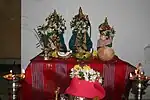 রাম নবমীতে বাড়ির মন্দির |
চৈত্র মাসের নবম দিন। (হিন্দু ক্যালেন্ডার) | রাম নবমী বা শ্রী রাম নবমী রামের জন্ম উদযাপন । রাম নবমী হল সেই দিন যেদিন ভগবান রাম, ভগবান বিষ্ণুর সপ্তম অবতার, অযোধ্যায় মানবরূপে অবতীর্ণ হন. তিনি বিষ্ণুর অর্ধাংশ বা ভগবান বিষ্ণুর অর্ধেক নির্দিষ্ট গুণাবলী রয়েছে। "রাম" শব্দের আক্ষরিক অর্থ হল সেই ব্যক্তি যিনি স্বর্গীয়ভাবে সুখী এবং যিনি অন্যদের আনন্দ দেন এবং যার মধ্যে ঋষিরা আনন্দ করেন। রাম নবমী চৈত্রের (এপ্রিল/মে) উজ্জ্বল পাক্ষিকের নবম দিনে পড়ে এবং বসন্ত নবরাত্রি বা চৈত দুর্গা পূজার সাথে মিলে যায়। তাই, কিছু অঞ্চলে উৎসবটি নয় দিন ব্যাপী বিস্তৃত। এই দিনটি, ভগবান রামের জন্মদিনকে চিহ্নিত করে রাম ও সীতার বিবাহের দিন হিসাবেও পালন করা হয় এবং এইভাবে কল্যাণোৎসব নামেও উল্লেখ করা হয়। ভগবান রামের জন্মস্থান অযোধ্যায় এই উৎসব উদযাপনের জন্য হাজার হাজার ভক্তের সমাগম নিয়ে একটি বিশাল মেলা অনুষ্ঠিত হয়। মেলাটি দুই দিন ধরে চলতে থাকে, এবং রাম, তাঁর ভাই লক্ষ্মণ, তাঁর স্ত্রী সীতা এবং তাঁর সর্বশ্রেষ্ঠ ভক্ত মহাবীর হনুমানের দেবতাদের বহন করে রথযাত্রা, প্রায় সব রাম মন্দির থেকে বের করা হয়। হনুমান রামের প্রতি তার ভক্তির জন্য পরিচিত, এবং তার গল্পগুলি উদযাপনের একটি গুরুত্বপূর্ণ অংশ তৈরি করে। অন্ধ্র প্রদেশে, মার্চ/এপ্রিল মাসে চৈত্র সপ্তমী থেকে বহুলা পদ্যমী পর্যন্ত 10 দিন ধরে রাম নবমী পালিত হয়। মন্দিরগুলি এই ঘটনাকে স্মরণ করার জন্য ভগবান রাম এবং সীতার বিবাহের পুনঃপ্রবর্তন করে যেহেতু এই দিনটি তাদের বিবাহ হয়েছিল।[8] | |
| গুড়ি পড়ওয়া, চৌত্রি চন্দ্র,
উগাদি, নভরেহ (চন্দ্রমনা নববর্ষ) |
 ঐতিহ্যবাহী গুড়ি |
চৈত্রের চাঁদের প্রথম দিন (হিন্দু ক্যালেন্ডার) | গুড়ি পাদওয়া / চেটিচাঁদ হিন্দু চান্দ্র মাসের চৈত্রের প্রথম দিনে উদযাপিত হয় এবং মারাঠি , কোঙ্কানি এবং সিন্ধিরা নববর্ষের দিন হিসাবে পালিত হয় । ব্রহ্ম পুরাণ অনুসারে , এই দিনেই ব্রহ্মা বিশ্ব সৃষ্টি করেছিলেন। |
| উগাদি |
 বোব্বাতলু বা হলিগে বা ভাকশালু উগাদিতে প্রস্তুত  উগাদি পচাদি |
উগাদি ( তেলেগু এবং কন্নড় ভাষায় যার অর্থ "একটি যুগের সূচনা" ) হল তেলেগু এবং কন্নড়ীগাদের জন্য নববর্ষের দিন । মহারাষ্ট্রে একে বলা হয় গুড়ি পাদওয়া । | |
| মেষ সংক্রান্তি
বা বৈশাখী |
 উত্তরাখণ্ডের হরিদ্বারে গঙ্গা |
বৈশাখ সৌর মাসের প্রথম দিন । | মেষ সংক্রান্তি ( বৈশাখ সংক্রান্তিও বলা হয়) সূর্যের মেষ (মেষ) রাশিতে পরিবর্তনের প্রতিনিধিত্ব করে। লুনিসোলার ক্যালেন্ডারে সৌর নববর্ষের সূচনা চিহ্নিত করে। পবিত্র জলে স্নান জড়িত। আঞ্চলিক নববর্ষের উৎসবগুলিও এই দিনে পালন করা হয় যেমন বিষু , পহেলা বৈশাখ , মহাবিশুভা সংক্রান্তি এবং বৈশাখী । ভার্নাল (বসন্ত) বিষুব প্রতিনিধিত্ব করে। |
| বিশু |
 সনাতন বিশু কানি |
বিশু কেরালায় পালিত একটি হিন্দু উৎসব । এটি গ্রেগরিয়ান বছরের 14 এপ্রিলের কাছাকাছি পড়ে। "বিশু" মানে সংস্কৃতে সমান। বিষু বসন্ত ঋতুর শুরুর প্রতীক। এই উত্সবটি এমন একটি পর্ব যা ভগবান বিষ্ণুর প্রতি উত্সর্গীকৃত। বিষু পরিবারের জন্য একটি উৎসব।[9] | |
| পুথান্ডু (তামিল নববর্ষ) |
The Tamil New Year follows the Nirayan vernal equinox. it falls around 14 April of the Gregorian year. | ||
| বিহু |
 'পেপা'-এর সঙ্গে বিহু নর্তকী |
Vaisakha/Bohag (Assamese Calendar) – The first month of Hindu calendar | Rongali Bihu (mid-April, also called Bohag Bihu), the most popular Bihu celebrates the onset of the Assamese New Year (around 15 April) and the coming of Spring. |
| হনুমান জয়ন্তী |
 শ্রী হনুমান মন্দির |
হনুমান জয়ন্তী হল রামের অনুগত ভক্ত হনুমানের জন্মের উদযাপন । হনুমান তার মহান শক্তি, শক্তি এবং ভগবান রামের প্রতি তার অমর ভক্তির জন্য পরিচিত। তাকে ভারতের অন্যতম শক্তিশালী হিন্দু দেবতা বলে মনে করা হয়। হনুমান জয়ন্তীর শুভ দিনে, লোকেরা তাদের কপালে ভগবানের পায়ের লাল সিন্দুর লাগায়। এটি সুস্বাস্থ্য এবং সৌভাগ্যের জন্য একটি আচার হিসাবে বিবেচনা করা হচ্ছে।[10] | |
| শীতল ষষ্ঠী |
জ্যৈষ্ঠ মাসের উজ্জ্বল পাক্ষিকের ষষ্ঠ দিন (হিন্দু ক্যালেন্ডার) | শিব ও পার্বতীর বিবাহ সিতালষষ্ঠী হিসাবে পালিত হয়। এটি একটি কার্নিভাল হিসাবে পালিত হয়, যেখানে বিভিন্ন স্তরের মানুষ এবং শিল্পীরা অংশগ্রহণ করে, এটিকে আরও সুন্দর করে তোলে এবং জীবনের আসল রঙ বের করে দেয়। | |
| বট সাবিত্রী
বা বট অমাবস্যা |
 বটগাছের চারপাশে সুতো বাঁধা ( ওয়াটা ) |
জ্যৈষ্ঠের পূর্ণিমা (হিন্দু ক্যালেন্ডার) | মহারাষ্ট্রে বট পূর্ণিমা পালন করা হয় । পূর্ণিমা মানে " পূর্ণিমা ।" মহিলারা বটগাছের চারপাশে সুতো বেঁধে তাদের স্বামীর সমৃদ্ধির জন্য প্রার্থনা করে । |
| বনলু |
 বনাম পরিক্রমা করছেন মহিলারা |
বোনালু হল তেলেঙ্গানায় মাতৃদেবীর (যেমন দেবী পোচাম্মা, ইয়েল্লাম্মা ইত্যাদি) জন্য পালিত একটি উৎসব। এটি দুটি শহর হায়দ্রাবাদ এবং সেকেন্দ্রাবাদে জুলাই এবং আগস্ট মাসের মধ্যে পালিত হয়। এই উৎসবটি ১৮১৩ সালে হায়দ্রাবাদ এবং সেকেন্দ্রাবাদে হয়। এই বার্ষিক হিন্দু উৎসবে দেবী মহাকালীর পূজা করা হয়।[11] | |
| বাথুকাম্মা |
 বাথুকাম্মাসকে ঘিরে মহিলারা নাচছেন |
বাথুকাম্মা হল তেলেঙ্গানার 10টি জেলায় সেপ্টেম্বর এবং অক্টোবর মাসে উদযাপিত একটি উৎসব। অঞ্চলের বহিরাগত ফুল সহ মহিলারা তেলেঙ্গানা, বাথুকাম্মার একটি উজ্জ্বল ফুলের উত্সব উদযাপন করতে আসে। এই উত্সবটি নয় দিন ধরে পালিত হয় এবং এটি তেলেঙ্গানার পরিচয় হিসাবে স্বীকৃত।[12] | |
| রথযাত্রা |
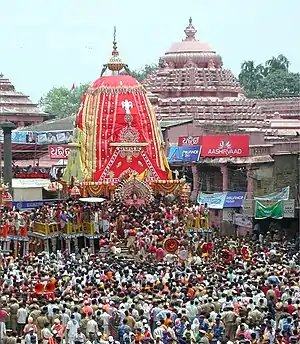 পুরীতে রথযাত্রা |
আষাঢ় মাসের চাঁদ পর্বের দ্বিতীয় থেকে দশম দিন (হিন্দু ক্যালেন্ডার) | রথযাত্রা জগন্নাথের সাথে যুক্ত উৎসব।এটি বাঙালি ও ওড়িয়াদের সবচেয়ে গুরুত্বপূর্ণ উৎসব। |
| রাজা পর্ব |
 Raja Doli khela, Oriya festival |
দ্বিতীয় দিন (রাজা সংক্রান্তি) মিথুন মাসের সূচনাকে বোঝায় | রাজা পার্ব চার দিনব্যাপী উৎসব। এটি সমগ্র উড়িষ্যা জুড়ে কৃষিবর্ষের উদ্বোধন ও স্বাগত জানায় । |
| গুরু পূর্ণিমা |
আষাঢ়ের পূর্ণিমা (হিন্দু ক্যালেন্ডার) | গুরু পূর্ণিমা হল সেই দিনটি যেদিন ভক্তরা তাদের গুরুকে পূজা (উপাসনা) করে । এই দিনেই মহাভারতের লেখক ব্যাস জন্মগ্রহণ করেছিলেন। | |
| মহালক্ষী ব্রত
বা ভারলক্ষ্মী ব্রতম |
 মহালক্ষ্মী  দক্ষিণ ভারতীয় পরিবারের ভারলক্ষ্মী ব্রত পূজার একটি সাধারণ দৃশ্য |
'ভার মহালক্ষ্মী ব্রত' পালিত হয় দ্বিতীয় শুক্রবার বা পূর্ণিমার দিনের আগের শুক্রবার - পূর্ণিমা - শ্রাবণ মাসে , যা জুলাই-আগস্টের গ্রেগরিয়ান মাসের সাথে মিলে যায়। | ভারলক্ষ্মী ব্রথাম বা মহালক্ষ্মী ব্রত হল একটি পূজা যা বিবাহিত হিন্দু মহিলাদের দ্বারা সম্পাদিত হয় মহালক্ষ্মীর আশীর্বাদ পাওয়ার জন্য , সম্পদ ও সমৃদ্ধির দেবী ।
এটি দক্ষিণ ভারতীয় রাজ্যগুলিতে ভারলক্ষ্মী ব্রথাম হিসাবে পালিত হয় । এটি বিবাহিত মহিলারা (সুমঙ্গলি) তাদের পরিবারের সকল সদস্যের মঙ্গল কামনা করে, বিশেষ করে স্বামীর, বংশধর ইত্যাদি লাভের জন্য করে থাকে। এটা বিশ্বাস করা হয় যে এই দিনে দেবী ভারলক্ষ্মীর পূজা করা অষ্টলক্ষ্মীর পূজার সমতুল্য । সম্পদ, পৃথিবী, জ্ঞান, প্রেম, খ্যাতি, শান্তি, তৃপ্তি এবং শক্তি। |
| ওণম্ |
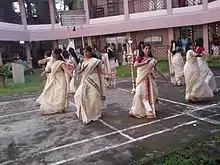 কেরালায় ওনামের সময় তিরুভাথিরা কালী |
ওনাম কেরালার ফসল কাটার উৎসব। যদিও ওনাম ঐতিহ্যগতভাবে কেরালায় পালিত হয়, সমসাময়িকভাবে ওনাম বিশ্বজুড়ে কেরালা প্রবাসীরা উদযাপন করে।
ওনাম ভগবান বিষ্ণুর পঞ্চম অবতার ভগবান বামনকে সম্মান জানায় এবং ভগবান বামনের জন্মদিন এবং তার পরোপকারী ভক্ত বালি ( ভক্ত প্রহ্লাদের নাতি ) এর বার্ষিক সফরকে চিহ্নিত করে।[13][14] এটি চিংগাম মাসে (আগস্ট-সেপ্টেম্বর) পড়ে এবং দশ দিন স্থায়ী হয়। উত্সবটি বিভিন্ন উত্সবের দ্বারা চিহ্নিত করা হয়, যার মধ্যে রয়েছে জটিল ফুলের কার্পেট, ওনাম সাদা (বিস্তৃত ভোজ লঞ্চ), স্নেক বোট রেস, ওনাপোত্তন, গুরুবায়ুরের কাজচাক্কুলা , পুলি কালী, কাইকোত্তিকলি ইত্যাদি। | |
| রাখীবন্ধন
বা |
 রাখি |
শ্রাবণের পূর্ণিমা (হিন্দু ক্যালেন্ডার) | রাখি পূর্ণিমা বা রক্ষা বন্ধন হল একটি উৎসব যা প্রধানত উত্তর ভারতের রাজ্যগুলিতে উদযাপিত হয়। রাখি একটি ভাই এবং বোনের মধ্যে ভালবাসার পবিত্র বন্ধন উদযাপনের একটি বিশেষ উপলক্ষ। |
| তীজ বা | রক্ষা বন্ধনের পর তৃতীয় দিন | "Teejdi" is a festival of Sindhis. On this day Sindhi ladies observe a day long fasting for longer life of their husbands. They take dinner after "Chandra Darshan" i.e. seeing Moon. | |
| শীতলা সাতম | Seventh Day after Raksha Bandhan | "Shitla Satam" is celebrated on the day after Raksha Bandhan. It is the day when a mother fasts for their children and eats food that is not warm. The ladies practice this fast by keeping the stove/gas turned off for a day. This day is generally observed by Gujarati Families. | |
 গোবিন্দ পাঠকরা মানব মিনার তৈরি করছে  জন্মাষ্টমীতে দিল্লির ইসকন মন্দির |
Eighth day of waning moon of Shravana (amanta) / Bhadrapad (purnimanta) | Krishnashtami or Krishna Janmaashtami is the Hindu festival celebrating the birth of Krishna. It is actually called as Krishna Jayanthi. The date falls not only on the eighth day of the waning moon of Bhadrapad, but always on Rohini Nakshatra. Janmashtami, the birthday of Lord Krishna is celebrated with great devotion and enthusiasm in India in July or August. According to the Hindu calendar this religious festival is celebrated on the Ashtami of Krishna Paksh or the 8th day of the dark fortnight in Bhadon. Sri Krishna is considered as the one of the most powerful human incarnations of the Lord Vishnu. He was born around 5,200 years ago in Mathura. The sole objective of Sri Krishna's birth was to free the Earth from the evilness of demons. He played an important role in Mahabharata and propagated the theory of bhakti and good karma which are narrated deeply in the Bhagavad Gita. Sri Krishna was born in a prison in the custody of Kansa. Vasudev, His father immediately thought of his friend Nand and decided to hand over his child to him to save Krishna from the clutch of Kansa. Krishna grew up in Gokul and finally killed his uncle, King Kansa. The actual celebration of Janmashtami takes place during the midnight as Sri Krishna is believed to be born on a dark, stormy and windy night to end the rule and violence of his uncle, Kansa. All over India this day is celebrated with devotional songs and dances, pujas, arti, blowing of the Conch and rocking the cradle of baby Sri Krishna. The Janmashtami celebration of Mathura and Vrindavan, the places where Sri Krishna had spent his life, are very special. On this day temples and homes are wonderfully decorated and illuminated. Night long prayers are offered and religious mantras are sung in the temples.[15] | |
| রাধাষ্টমী |
 রাধা রাণী  ইসকধ বৃন্দাবনে রাধা অষ্টমী পালন |
Eighth day of waxing moon of Bhadrapad (Hindu calendar) | Radhashtami is celebrated all across India especially in Northern India on Bhadrapad Shukla Paksha Ashtami as birth anniversary of Goddess Radha, consort of Lord Krishna. |
| গৌরী উৎসব বা | Gowri Habba is celebrated in Karnataka, Andhra Pradesh, and Tamil Nadu. Gowri is worshipped for her ability to bestow courage to her devotees. Newly wed couples are invited to the house of the groom's parents and served with varieties of food. | ||
| গণেশ চতুর্থী
|
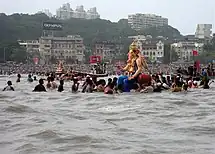 Ganesh Visarjan in Mumbai |
Fourth day of the waxing moon of Bhadrapada (Hindu calendar) | Vinayaka Chavithi or Ganesh Chaturthi is the celebrated as the arrival of Ganesh on the earth. It is very important festival in Maharashta. Ganesh Festival celebrated in Pune in very traditional way. |
| নুয়াখাই |
Fifth day of the waxing moon of Bhadrapada (Hindu calendar) | Nuakhai is celebrated to welcome the new rice of the season. This is an agricultural festival mainly observed by people of western Odisha (Kosal). | |
| নবরাত্রি |
 Garba dance in Ahmedabad |
First nine nights of the waxing moon of Ashvin | Navarathri is the Hindu festival of worship and dance. In Sanskrit the term literally means "nine nights". During this festival the forms of Shakti are worshipped. Literally “nine nights”, this nine – day period from the new moon day to the ninth day of Ashvin is considered the most auspicious time of the Hindu calendar and is hence the most celebrated time of the year. Although it has different names in different parts of India, Hindus from all regions celebrate it. From Kashmir in the North to Tamil Nadu in the South, and from Gujarat in the West to Sikkim in the East, it is celebrated with great enthusiasm as the conquest of good over evil. Every region has its own myths and reasons to explain this. The nine different aspects of Devi are worshipped over the nine days. |
| দুর্গাপূজা |
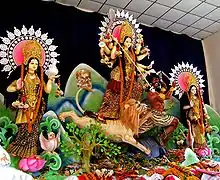 Durga Puja celebration in Dhaka |
First ten nights of the waxing moon of Ashvin | These are the most popular forms under which she is worshipped: Durga, goddess beyond reach; Kali, the auspicious power of time; Amba or Jagdamba, mother of the world; Annapurna, giver of food and plenty; Sarvamangala, auspicious goddess; Bhairavi, terrible, fearful, power of death; Chandika or Chandi, violent, wrathful, furious; Lalita, playful; Bhavani, giver of existence; Tara, giver of success in work. It is the most important festival of Bengalis and Odias. |
| বিজয়া দশমী |
Tenth day of waxing moon of Ashvin (Hindu calendar) | Vijayadashami is the Hindu celebration of good over evil. | |
| গোবৎস দ্বাদশী |
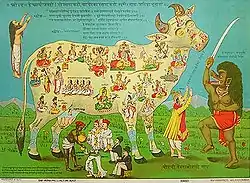 পবিত্র গাভী কামধেনুকে তার শরীরের মধ্যে বিভিন্ন দেবতা ধারণ করে রেখেছে। |
Twelfth day of the waning moon fortnight (Krishna Paksha) in the month of Kartik (Hindu calendar) | Govatsa Dwadashi is the worship of cows as chief source of livelihood and religious sanctity; being the first day of Diwali celebrations. Sripada Vallabha Aradhana Utsav of Sripada Sri Vallabha, at Pithapuram Datta Mahasamsthan in the state of Andhra Pradesh.
Dhanteras - Dhanteras (Hindi: धनतेरस), also known as Dhanatrayodashi (Sanskrit: धनत्रयोदशी), is the first day that marks the festival of Diwali in India. It is celebrated on the thirteenth lunar day of Krishna Paksha (dark fortnight) in the Hindi calendar month of Ashvin. Dhanvantari, who is also worshipped on the occasion of Dhanteras, is considered the God of Ayurveda who imparted the wisdom of Ayurveda for the betterment of mankind, and to help rid it of the suffering of disease. The Indian ministry of Ayurveda, Yoga and Naturopathy, Unani, Siddha and Homeopathy, announced its decision to observe Dhanteras, as the "National Ayurveda Day", which was first observed on 28 October 2016. Usually, Gujarati families will enjoy a meal of daal baath and malpura to ring in the new year. |
| দীপাবলি |
 আলপনা সজ্জা  দীপাবলির সময় একটি শিশু ফুলবাজা বা স্পার্কলার নিয়ে খেলছে  দীপাবলির রাতে চেন্নাই জুড়ে আতশবাজি |
New moon of Ashvin (amanta) / Kartika (purnimanta) | Deepavali which means "row of lights/lamps" in Kannada and Telugu and Marathi and Sanskrit is called "Diwali" in North India, Deepa means lamp and in Hindi a lamp is mostly called a Diya or Di. The festival is celebrated on the occasion of Lord Krishna and his wife Satyabhama killing a demon Narakasura. Another story says the festival is celebrated for the return of Rama and Sita to the kingdom Ayodhya after fourteen years of exile.
Rama is exiled to the forest for 14 years, his devoted wife Sita and humble brother Laxman decide to join him, after 14 years the whole village know he is returning so light lamps or 'divas' to guide him, his wife and brother home. So every year lamps are lit to represent Rama finding his way back home after the harsh punishment of being sent to exile in the forest. |
| ভাইফোঁটা (ভাতৃদ্বিতীয়া) |
Second day of the waxing moon of Kartik (Hindu calendar) | Bhai dooj, also referred to as Bhaubeej in Marathi or Bhaiphonta in Bengali, is the ceremony performed by Hindus, generally, on the second day of Deepavali. It is celebrated among brothers and sisters and is similar to Raksha Bandhan, except there is no tying of rakhi involved. | |
| করবা চৌথ (কার্ক চতুর্থী) বা আটলা তদ্দে |
 মহিলারা করভা চৌথ পালন করছেন |
Four days after purnima (a full moon) in the month of Ashvin (amanta) Kartika (purnimanta). Like many Hindu festivals, Karva Chauth is based on the lunisolar calendar which accounts for all astronomical positions, especially positions of the moon which is used as a marker to calculate important dates. The festival falls on the fourth day after the full moon, in the Hindu lunisolar calendar month of Kartik | Karva Chauth is a one-day festival celebrated by Hindu women from some regions of India, especially northern India. On Karva Chauth, the married women, especially in Northern India, fast from sunrise to moonrise for the safety and longevity of their husbands.[17][18][19] The Karva Chauth fast is traditionally celebrated in the states of Delhi, Haryana, Rajasthan, Punjab, Jammu, Uttar Pradesh, Himachal Pradesh and Madhya Pradesh.[17][20][21][22] It is celebrated as Atla Tadde in Andhra Pradesh. |
| কার্তিক পূর্ণিমা |
15th of the Full moon day of Kartik (November–December) | A unique festival is celebrated in Varanasi this day which is called Dev Devali. The Kartik Purnima festival also coincides with the Jain light festival and Guru Nanak Jayanti | |
| ছট পূজা |
 Morning worship at Jamshedpur |
Chhath is mainly observed in Bihar and Terai, but is also celebrated elsewhere. It is a festival dedicated to the Sun God for bestowing the bounties of life and fulfilling wishes. During Chath, devotees worship God Surya early in the morning. | |
সূরসংহার |
Skanda Sashti is decided on lunar month during the sixth day of Karthika Masam (October–November). It is one of the most important festival dedicated to Lord Murugan the second son of Shiva. On this festival is celebrated the victory of Murugan against the Asuras. | ||
| খন্ডোবা |
Champa Sashti festival is a six-day festival observed from the first to the sixth of the Hindu month of Margashirsha (November – early December). It is one of the most important festivals dedicated to Lord Khandoba.This festival celebrates the victory of Khandoba against the demons Mani-Malla. | ||
প্রথমাষ্টমী |
After 8 days of Kartik Purnima | Prathamastami is a festival that originated in Odia. It is held on the eighth day of the month of Agrahayana, when older female relatives pray for the prosperity of their eldest child. The festival is followed by rituals and recitations of the Glory of Mahalakshmi and Shashti Devi. | |
| যাত্রা |
 Dnyaneshwar's palkhi holding the footwear of the saint |
Yatra (also Zatra and jatra) refers to the pilgrimage festivals celebrated at Hindu temples. Idols and murtis are taken out on special procession in a palkhi (a palanquin) or a chariot called the rath. Every temple observes this festival once a year on the traditional day. Palkhi is main tradition of Maharashtra. Sant Dhnyaneshwar had started the palkhi from Alandi (Pune) to Pandharpur. Every year Marathi people celebrates Palkhi from Alandi and Dehu to Pandharpur. | |
| কার্তিক দীপদান
বা কার্তিক দীপম |
Kartika Deepam or Karthikai Deepam is an ancient festival of lights celebrated by Tamil Hindus and Telugu Hindus on the full moon day of Karthikai/Kartika month (November/December). This occurs on the day when the moon is in conjunction with the constellation Karthigai (Pleiades) and purnima. It is the same as Kartik Poornima; however, since Tamils follow the Hindu Solar calendar with correction for precession of the equinoxes, the Tamil date matches the actual constellation. | ||
| পঞ্চ গণপতি |
A Winter Solstice celebration that lasts five days. | Pancha Ganapati is a modern Hindu festival celebrating Lord Ganesha, the Five-Faced Maha Ganapati—Lord of Categories. | |
| কুম্ভমেলা |
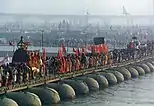 Procession of Akharas marching over the Ganges. |
A pilgrimage made every three years to the Ganges river | The Purna (complete) Kumbh takes place every twelve years, and is an ordinary large Kumbh Mela. The Ardh (half) Kumbh Mella, a smaller Kumbh Mela, is celebrated every six years. The normal Kumbh Mela is celebrated every 3 years. The Maha (great) Kumbh Mela, a special large Kumbh Mela, occurs every 12 'Purna Kumbh Melas', or 144 years. |
| গোদাবরী মহা পুষ্করম বা পূর্ণ কুম্ভমেলা |
 Stage of Godavari Aarathi in Rajamundry |
Godavari Pushkaram or Godavari Pushkaralu is most commonly stated as it is the festival of the river Godavari. The main significance of this Godavari Pushkaralu is that It occurs once in every 12 years in other words called as Pushakara. The river Godavari took it birth at triambakeswar of Nasik which is located in Maharashtra state. It flow along the various regions of Andhra Pradesh, Telangana, Maharashtra and Karnataka and finally flows into the Bay of Bengal. Maha Pushkaralu which comes once in 144 years.
Main centre's that celebrate Pushkaram are Rajahmundry, Bhadrachalam, Trimbakeshwar & Nashik. Most of the Godavari River is connected with Rajahmundry, where it has wide spread across the city. | |
| সামা চাকেবা | "Sama Chakeva (Nepali or Hindi: सामाचकेवा) is an important festival observed by Mithila region that extends from Terai of Nepal to Bihar and Jharkhanda states of India. With great enthusiasm, young brothers and sisters celebrate this festival in Kartik as per Bikram Sambat Calendar, in November, when birds traditionally begin the migration of beautiful and colourful birds from the Himalayas to plain parts of Nepal (Terai) and India. This festival demonstrates love and affection between brothers and sisters.
This festival begins immediately after the conclusion of Chhath festival in Nepal and northern parts of India, and ends on the full moon day of Kartik, that coincides in the month of November." | ||
| তুলসী পূজা |
December 25 every year | Tulsi Pujan Diwas is celebrated on December's 25 by Hindus in India. Tulsi in Hinduism is used for medicinal and spiritual use. It is considered sacred in Hinduism and it is believed that Tulsi brings prosperity. | |
| নাগ পঞ্চমী |
 Nagabana at Belle Badagumane, Moodubelle, Udupi |
Fifth day of Shravan month of the Lunar calendar | Naga Panchami is a traditional worship of snakes or serpents observed by Hindus throughout India, Nepal and other countries where Hindu adherents live. |
আরো দেখুন
- হিন্দু সাম্রাজ্য এবং রাজবংশের তালিকা
- হিন্দু ক্যালেন্ডারের জ্যোতির্বিজ্ঞানের ভিত্তি
- হিন্দু রীতির প্রত্নতত্ত্ব
- হিন্দুধর্মের ইতিহাস
- দেশ অনুযায়ী হিন্দুধর্ম
- হিন্দু পঞ্জিকা
পদটীকা
তথ্যসূত্র
- Gowda, Prabhu (২০১৭-০৮-০৮)। "10 Hindu Festivals You Should Know About"। Culture Trip। সংগ্রহের তারিখ ২০২১-০৯-২৬।
- Post Jagran Article 15 01 2014
- , Pongalfestival.org.
- Friedrichs, Kurt (১৯৯৪)। "Sarasvatī"
 । Schuhmacher, Stephan; Woerner, Gert। The Encyclopedia of Eastern Philosophy and Religion: Buddhism, Hinduism, Taoism, Zen। Boston: Shambala। পৃষ্ঠা 306। আইএসবিএন 0-87773-980-3।
। Schuhmacher, Stephan; Woerner, Gert। The Encyclopedia of Eastern Philosophy and Religion: Buddhism, Hinduism, Taoism, Zen। Boston: Shambala। পৃষ্ঠা 306। আইএসবিএন 0-87773-980-3। The goddess of ... scholarship ... She is also the patron of the arts, especially of music.
- Kent, Alexandra. Divinity and Diversity: A Hindu Revitalization Movement in Malaysia. University of Hawaii Press, 2005. (আইএসবিএন ৮৭৯১১১৪৮৯৬)
- Hume, Lynne. Portals.
- "Mahashivaratri Festival : Festival of Shivratri, Mahashivratri Festival India – Mahashivaratri Festival 2019"। Mahashivratri.org। সংগ্রহের তারিখ ২০১৮-০৪-২২।
- "Rama Navami – Hindupedia, the Hindu Encyclopedia"। Hindupedia.com। সংগ্রহের তারিখ ২০১৮-০৪-২২।
- "Story Behind Vishu Festival"। www.vishufestival.org। সংগ্রহের তারিখ ২০১৯-১১-০১।
- "Hanuman Jayanti – Hanuman Jayanti 2018 Date – Celebrations in India"। Indiaonlinepages.com। ২০১৮-০৩-৩১। সংগ্রহের তারিখ ২০১৮-০৪-২২।
- "Telangana Tourism – Visit for all reasons & all seasons"। www.telanganatourism.gov.in (ইংরেজি ভাষায়)। সংগ্রহের তারিখ ২০১৯-১১-০১।
- "About Bathukamma | Bathukamma – Telangana's Floral Festival"। bathukamma.telangana.gov.in। সংগ্রহের তারিখ ২০১৯-১১-০১।
- Rinehart, Robin; Rinehart, Robert (২০০৪)। Contemporary Hinduism: Ritual, Culture, and Practice (ইংরেজি ভাষায়)। ABC-CLIO। আইএসবিএন 978-1-57607-905-8।
- Kumar, Ajith (২০১৯-১২-১৪)। The Murder of Alexander the Great, Book 1: The Puranas: Book 1: The Puranas (ইংরেজি ভাষায়)। Argead Star llc। আইএসবিএন 978-0-9990714-0-3।
- "Janmashtami / Krishna Janmashtami : A hindu religious festival"। Calendarlabs.com। ২০১৮-০৩-০৯। সংগ্রহের তারিখ ২০১৮-০৪-২২।
- "Indian Festivals"। Webonautics.com। সংগ্রহের তারিখ ২০১৮-০৪-২২।
- Kartar Singh Bhalla (২০০৫), Let's Know Festivals of India, Star Publications, আইএসবিএন 978-81-7650-165-1,
... 'Karva Chauth' is a ritual of fasting celebrated by married women seeking longevity, ... married women in the northern and western parts of India, especially Delhi, Uttarakhand, Haryana, Rajashtan, Punjab, vJammu, Uttar Pradesh, Bihar, and Jharkhand ... eat a little food before sunrise and start the fast ... After the moon rises ... finally, break their fast ...
টেমপ্লেট:Page? - S. K. Rait (২০০৫), women in England: their religious and cultural beliefs and social practices, Trentham Books, আইএসবিএন 978-1-85856-353-4,
... Karva Chauth, a fast kept to secure the long life of husbands, was popular among women ...
- টেমপ্লেট:Filmiwood| title= Makar Sankranti Top 10 Facts You should know about ||date=January 2018 |bot=InternetArchiveBot |fix-attempted=yes }}
- Kumar, Anu (২০০৭-১০-২১)। "A Hungry Heart"। The Washington Post।
- Subhashini Aryan (১৯৯৩), Crafts of Himachal PradeshLiving traditions of India, Mapin, আইএসবিএন 978-0-944142-46-2,
... Karva Chauth, when all married women universally fast a small pot, Karva, is required ...
- Anne Mackenzie Pearson (১৯৯৬), Because it gives me peace of mind: ritual fasts in the religious lives of Hindu women (McGill studies in the history of religions), SUNY Press, আইএসবিএন 978-0-7914-3038-5,
... Karva Chauth seems to be in western Uttar Pradesh ...
বহিঃসংযোগ
- Festivals, Ministry of Culture
